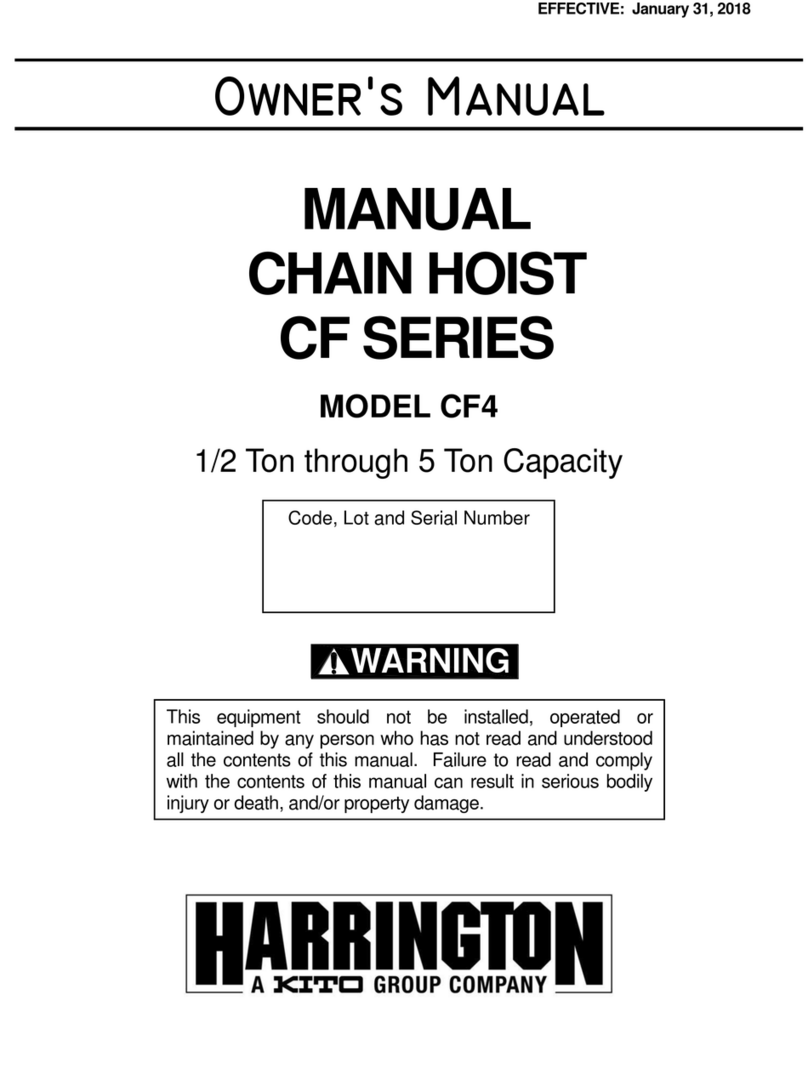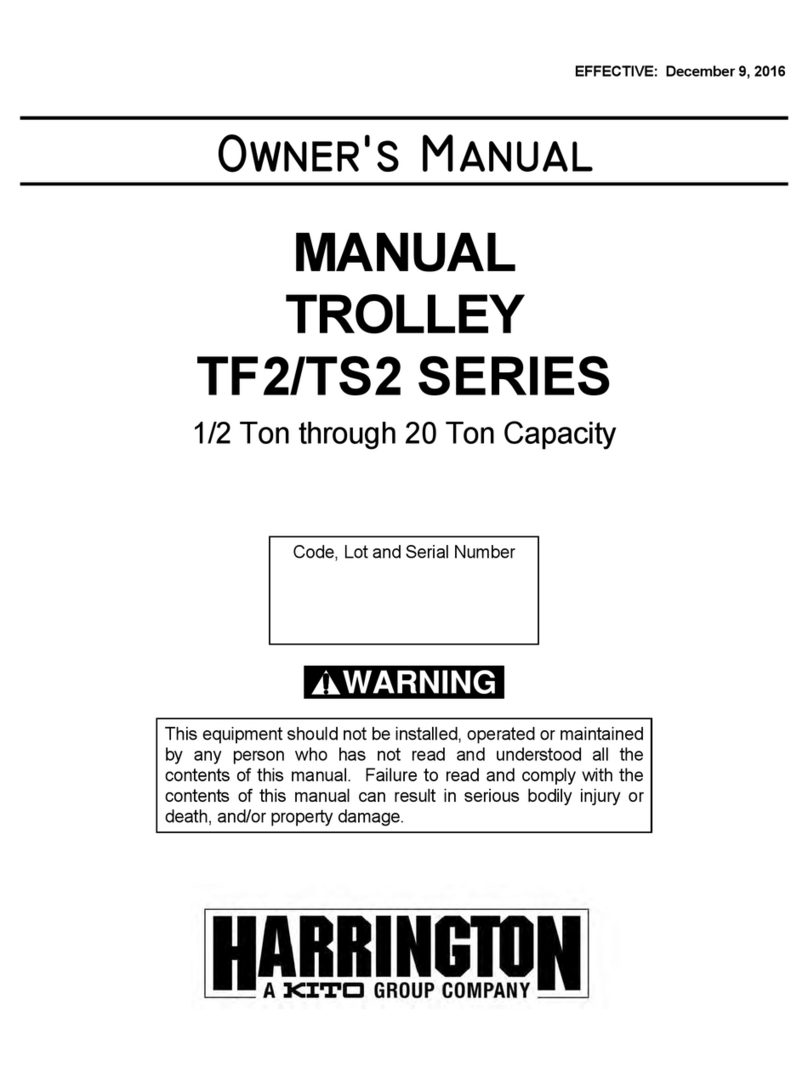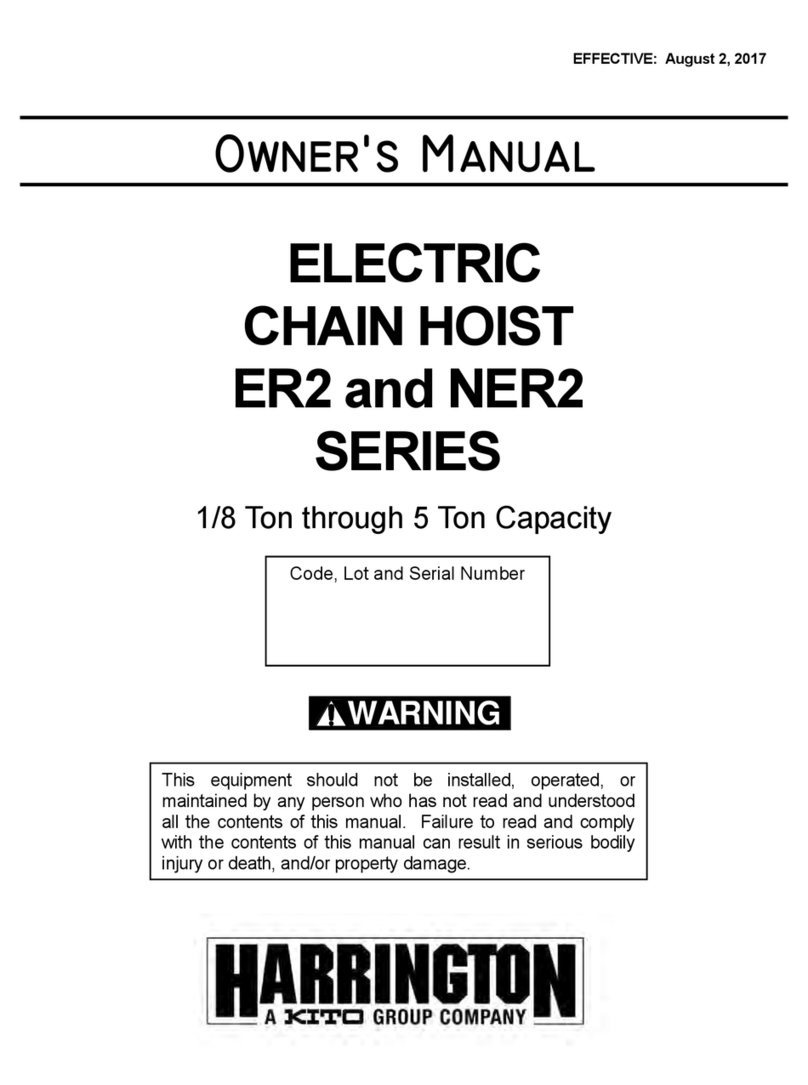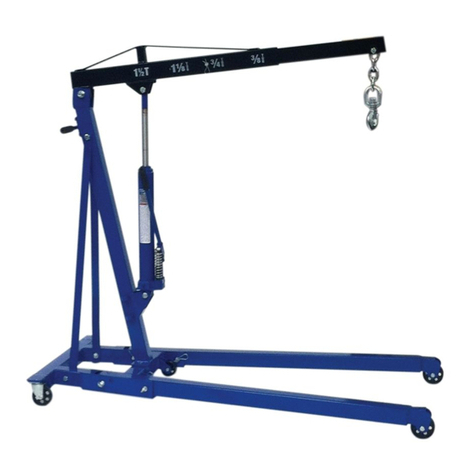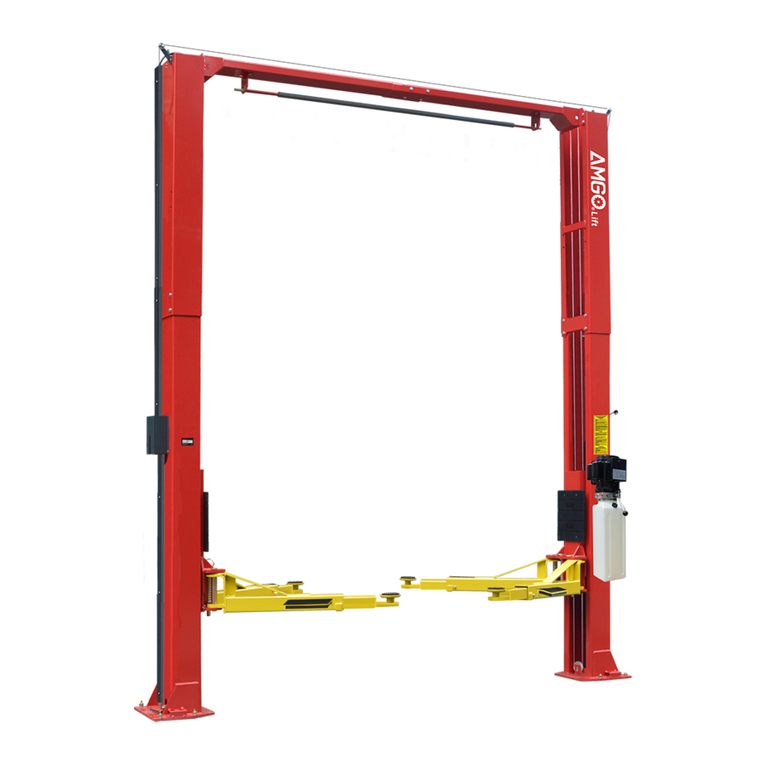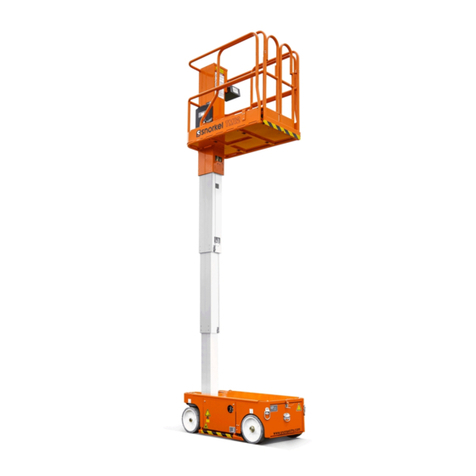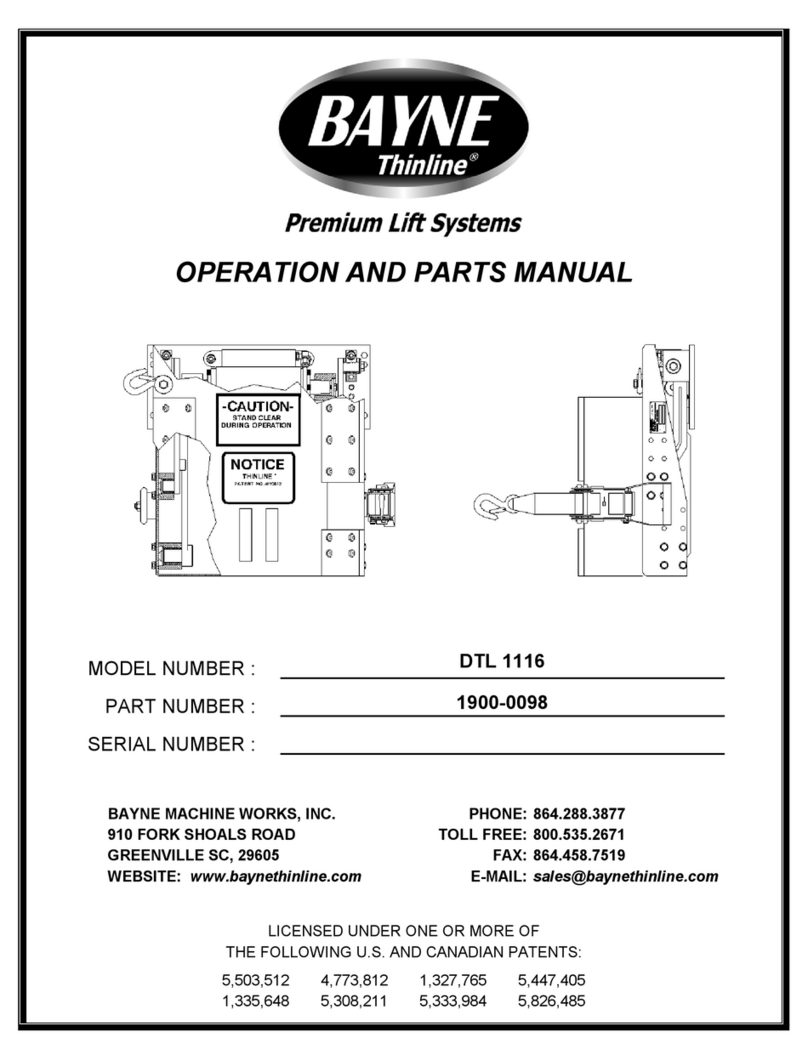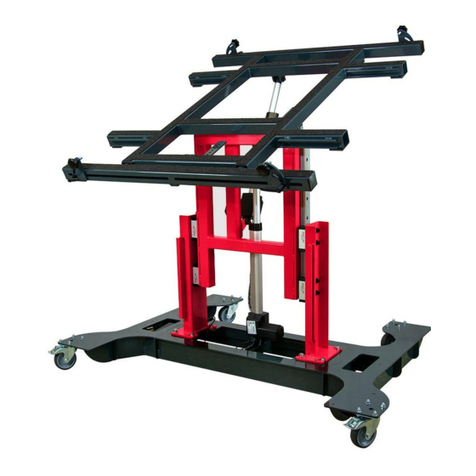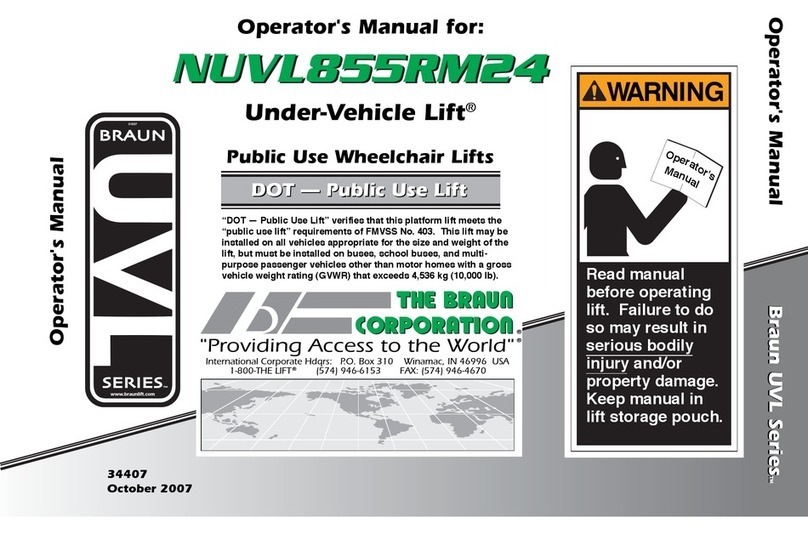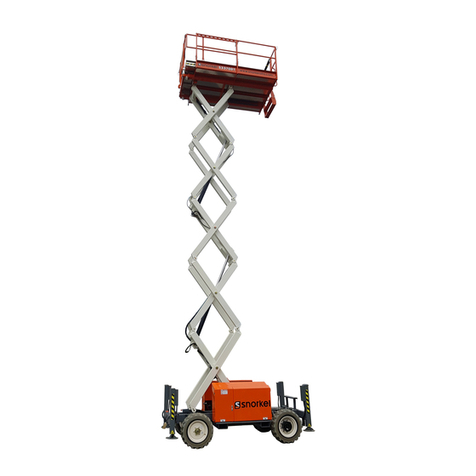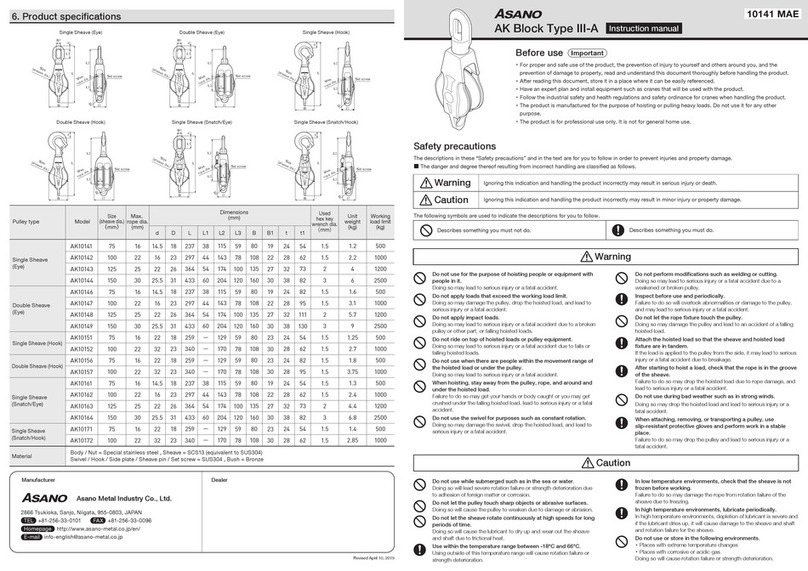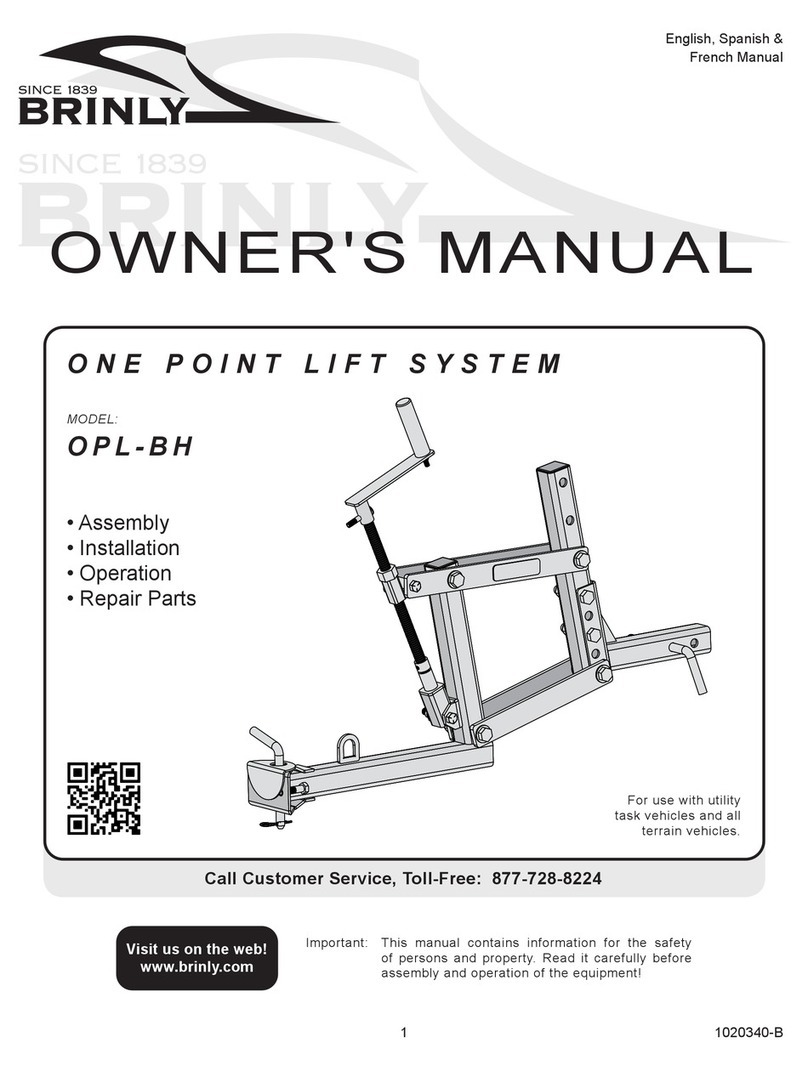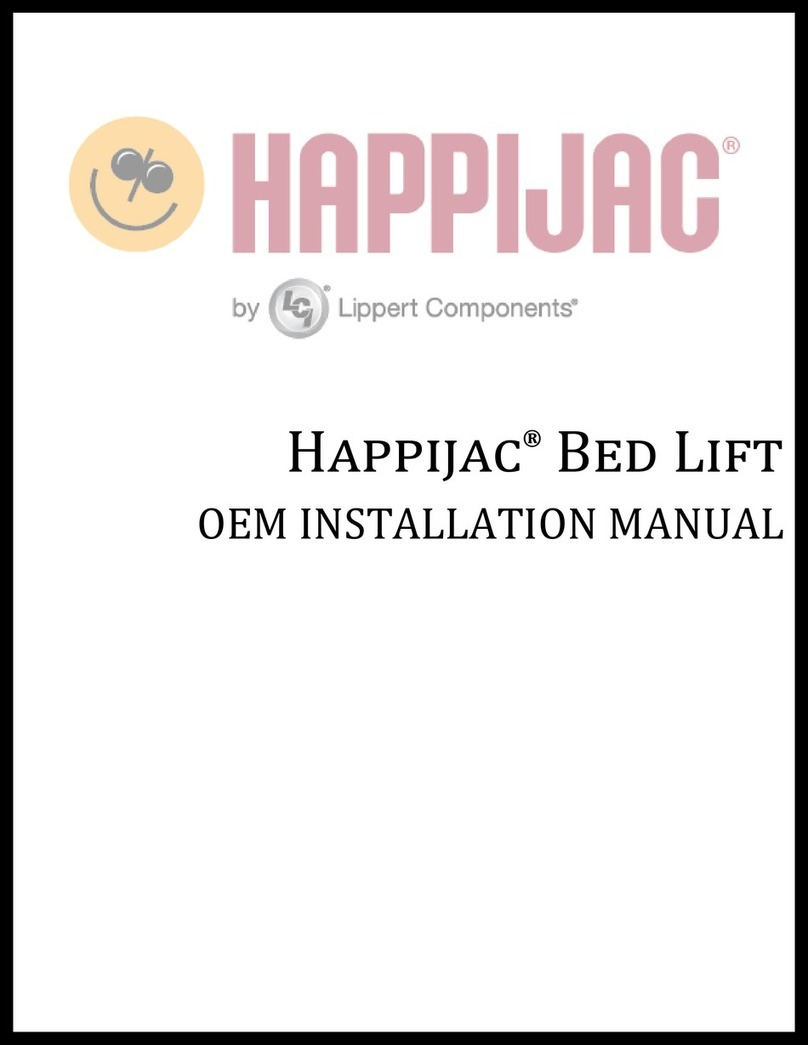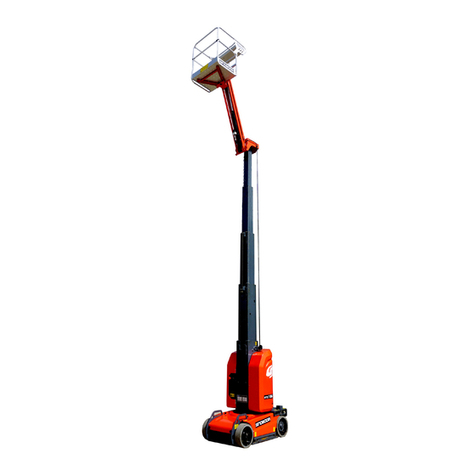Harrington CX Series User manual

Page 1 of 8
CX HAND CHAIN HOIST
OWNER’S MANUAL
¼ Ton and ½ Ton Capacity
Effective: May 9, 2017
WARNING
This equipment should not be installed,
operated or maintained by any person who has not read and
understood all the contents of this manual. Failure to read and
comply with the contents of this manual can result in serious bodily
injury or death, and/or property damage. Record the lot and serial
number in the space provided below.
Lot Number:
Serial Number:
Table of Contents
1.0 IMPORTANT INFORMATION AND WARNINGS……………. 1
2.0 TECHNICAL INFORMATION………………………………….. 2
3.0 PREOPERATIONAL PROCEDURES………………………. 2
4.0 OPERATION ……………………………………………………. 3
5.0 INSPECTION…………………………………………………….. 3
6.0 MAINTENANCE…………………………………………………. 6
7.0 WARRANTY …………………………………………………….. 6
8.0 PARTS LIST …………………………………………………….. 7
1.0 Important Information and Warnings
1.1 Terms and Summary
This manual provides important information for personnel involved with the installation, operation and maintenance of this product.
Although you may be familiar with this or similar equipment, it is strongly recommended that you read this manual before installing, operating
or maintaining the product.
Danger, Warning, Caution and Notice – Throughout this manual there are steps and procedures that can present hazardous situations.
The following signal words are used to identify the degree or level of hazard seriousness.
DANGER
Danger indicates an imminently hazardous situation which, if not avoided, will result in death or serious injury, and
property damage.
WARNING
Warning indicates an imminently hazardous situation which, if not avoided, could result in death or serious injury, and
property damage.
CAUTION
Caution indicates a potentially hazardous situation which, if not avoided, may result minor or moderate injury or
property damage.
NOTICE
Notice is used to notify people of installation, operation, or maintenance information which is important but not directly
hazard-related.
This manual chain hoist is designed and manufactured to lift and lower a load manually within a normal work environment. Movement in
the horizontal direction is also enabled by combining with a trolley. The operation of a hoist involves more than activating the hoist’s
controls. Per the ANSI/ASME B30 standards, the use of a hoist is subject to certain hazards that cannot be mitigated by engineered
features, but only by the exercise of intelligence, care, common sense, and experience in anticipating the effects and results of activating
the hoist’s controls. Use this guidance in conjunction with other warnings, cautions, and notices in this manual to govern the operation and
use of your hoist.
1.2 Shall’s and Shall Not’s for Operation
WARNING
Improper operation of a hoist can create a potentially hazardous situation which, if not
avoided, could result in death or serious injury, and substantial property damage. To
avoid such a potentially hazardous situation THE OPERATOR SHALL:
•
NOT
use hoist before reading Owner's Manual.
•NOT lift more than rated load for the hoist.
•NOT operate a hoist which has been modified without the
manufacturer's approval or certification to be in conformity with
applicable OSHA regs.
•NOT operate hoist when it is restricted from forming a straight
line from hook to hook in the direction of loading.
•NOT use hoist with twisted, kinked, damaged, or worn chain.
•NOT use damaged hoist or hoist that is not working properly.
•NOT operate a malfunctioning or unusually performing hoist.
•NOT use the hoist to lift, support, or transport people.
•NOT lift loads over people.
•NOT remove or obscure the warnings on the hoist.
•NOT use load chain as a sling or wrap load chain around load.
•NOT use in a way that causes either hook to be side loaded.
•NOT apply the load to the tip of the hook or to the hook latch.
•NOT use hoist if hook latch is missing or malfunctioning.
•NOT apply load unless load chain is properly seated in the load
sheave.
•NOT use the hoist in such a way that could result in shock or
impact loads being applied to the hoist.
•NOT attempt to lengthen the load chain or repair damaged load
•
NOT
leave load supported by the hoist unattended unless
specific precautions have been taken.
•NOT allow the chain, or hook to be used as an electrical or
welding ground.
•NOT allow the chain, or hook to be touched by a live welding
electrode.
•NOT operate a hoist on which the safety placards or decals are
missing or illegible.
• Be familiar with operating controls, procedures, and warnings.
• Make sure the unit is securely attached to a suitable support
before applying load.
• Make sure load slings or other approved single attachments are
properly sized, rigged, and seated in the hook saddle.
• Take up slack carefully - make sure load is balanced and load-
holding action is secure before continuing.
• Make sure all persons stay clear of the supported load.
• Protect the hoist’s load chain from weld splatter or other
damaging contaminants.
• Report Malfunctions or unusual performances (including unusual
noises) of the hoist and remove the hoist from service until the
malfunction or unusual performance is resolved.
• Warn personnel before lifting or moving a load.

Page 2 of 8
chain or hand chain.
•NOT operate beyond the limits of the load chain travel.
• Warn personnel of an approaching load.
• Maintain a firm footing or be otherwise secured when operating
the hoist.
• Check brake function by tensioning the hoist prior to each lift
operation.
• Use hook latches. Latches are to retain slings, chains, etc. under
slack conditions only.
• Make sure the hook latches are closed and not supporting any
parts of the load.
• Make sure the load is free to move and will clear all obstructions.
• Avoid swinging the load or hook.
• Make sure hook travel is in the same direction as shown on
controls.
•Inspect the hoist regularly, replace damaged or worn parts, and
keep appropriate records of maintenance.
• Use the hoist manufacturer’s recommended parts when repairing
the unit.
• Lubricate load chain per hoist manufacturer’s recommendations.
• NOT allow your attention to be diverted from operating the hoist.
• NOT allow the hoist to be subjected to sharp contact with other
hoists, structures, or objects through misuse.
• NOT adjust or repair the hoist unless qualified to
perform such adjustments or repairs.
• NOT use the hoist load limiting or warning device to measure load.
•NOT operate except with manual power
•NOT permit more than one operator to pull on a single hand chain
at the same time. More than one operator is likely to cause hoist
overload.
2.0 Technical Information
2.1 Specifications
2.1.1 Operating Conditions and Environment:
Temperature Range: -40° to +140°F
(-40° to +60°C)
Humidity: 100% or less
This is not underwater device.
Material: No special materials such as spark
resistant and asbestos.
Do Not Use: In an alkaline/acidic or an organic
solvent/explosive atmosphere.
2.1.2 Hoist Specifications:
Product Code CX003 CX005
Capacity (Ton) 1/4 1/2
Headroom C (in.) 8.5 10.2
Standard Lift (ft) 10 or 20 10 or 20
Pull to Lift Rated Load (lbs) 33 42
Overhaul Ratio 34 43
Load Chain Dia. x Pitch (mm) 3.2 x 9.0 4.3 x 12.0
Chain Fall Lines 1 1
Net Weight(lbs) 10 ft Lift 7 10
20 ft Lift 10 16
2.1.3 Hoist Parts
3.0 Preoperational Procedures
3.1 Mounting Location
3.1.1
WARNING
Prior to mounting the hoist ensure that the suspension and the supporting structure are adequate to support the hoist
and its loads. If necessary consult a professional that is qualified to evaluate the adequacy of the suspension location and its
supporting structure. The maximum force which can be applied to the supporting structure is 2.4 times the rated capacity.
3.2 Mounting the Hoist
3.2.1 Manual Trolley – Follow instructions in Owner's Manual provided with the trolley.
3.2.2 Hook Mounted to a Fixed Location - Attach the hoist’s top hook to the fixed suspension point.
3.2.3
WARNING
Ensure that the fixed suspension point rests on the center of the hook’s saddle and that the hook’s latch is engaged.
3.3 Preoperational Checks and Trial Operations
3.3.1
WARNING
Confirm the adequacy of the rated capacity for all slings, chains, wire ropes and all other lifting attachments before
use. Inspect all load suspension members for damage prior to use and replace or repair all damaged parts.
3.3.2 Measure and record the “k” dimension of the top and bottom hook. See Table 5-4 under Section 5.0, “Inspection”.
3.3.3 Record the hoist's Code, Lot and Serial Number (from the name plate on the hoist; see Section 2.1.4) in the space provided on the
cover of this manual.
3.3.4 Ensure that the hoist is properly installed to a fixed point.
3.3.5 Ensure that all nuts and bolts are sufficiently fastened.
CAUTION
Improper operation of a hoist can create a potentially hazardous situation which, if not avoided, could result in minor or
moderate injury, or property damage. To avoid such a potentially hazardous situation THE OPERATOR SHALL:

Page 3 of 8
3.3.6 Confirm proper operation:
Before operating read and become familiar with Section 4 - Operation.
Before operating ensure that the hoist meets the Inspection, Testing and Maintenance requirements of ANSI/ASME B30.16.
Before operating ensure that nothing will interfere with the full range of the hoist’s operation.
4.0 Operation
4.1 Introduction
4.1.1
WARNING
HOIST OPERATORS SHALL BE REQUIRED TO READ THE OPERATION SECTION OF THIS MANUAL, THE
WARNINGS CONTAINED IN THIS MANUAL, INSTRUCTION AND WARNING LABELS ON THE HOIST OR LIFTING SYSTEM,
AND THE OPERATION SECTIONS OF ANSI/ASME B30.16 and ANSI/ASME B30.10.
4.2 Lifting and Lowering
4.2.1 Refer to the arrows and text on the hand wheel cover –
see Figure 4-1.
4.2.2 To LIFT the Load – When facing the hand wheel side of
the hoist, pull down on the RIGHT side hand chain.
4.2.3 To LOWER the Load – When facing the hand wheel side
of the hoist, pull down on the LEFT side hand chain.
4.2.4
WARNING
This product is designed for a rated load to
be hoisted by pulling the hand chain with a force of 33 lb
(15kg) or less. Do NOT pull on the hand chain with a
force greater than 33 lb (15kgf). Stop using the hoist and
consult a qualified person if the a load of 1/4 Ton or less
cannot be lifted with a pull force of 33 lb (15kgf) or less. Figure 4-1 Lifting and Lowering
5.0 Inspection
5.1 Initial Inspection – Prior to initial use, all new, altered, or modified hoists shall be inspected by a designated person to ensure compliance
with the applicable provisions of this manual.
5.2 Inspection Classification – The inspection procedure herein is based on ANSI/ASME B30.16. Inspections for hoists in regular service
are divided into FREQUENT and PERIODIC groups based upon the intervals at which inspection should be performed. The intervals in
turn are dependent upon the degree of service and usage the hoists are subjected to. The two general classifications are herein
designated as FREQUENT and PERIODIC, with respective intervals between inspections as defined in Table 4-1.
Table 5-1 Inspection Intervals
Service FREQUENT Inspection PERIODIC Inspection
Normal Service Monthly Yearly
Heavy Service Weekly to Monthly Semiannually
Severe Service Daily to Weekly Quarterly
Special or Infrequent Service As recommended by a qualified
person before and after each
occurrence.
As recommended by a qualified person before
the first such occurrence and as directed by the
qualified person for any subsequent occurrences.
5.3 Frequent Inspection
5.3.1 Inspections should be made on a FREQUENT basis in accordance with Table 5-2, “Frequent Inspection.” Included in these
FREQUENT Inspections are observations made during operation for any defects or damage that might appear between Periodic
Inspections. Evaluation and resolution of the results of FREQUENT Inspections shall be made by a designated person such that
the hoist is maintained in safe working condition.
Table 5-2 Frequent Inspection
All functional operating mechanisms for proper operation and adjustment, maladjustment and unusual sounds.
Hoist braking system for proper operation
Hooks and latches in accordance with ANSI/ASME B30.10
Hook latch operation
Load chain in accordance with Section 5.5
Hoist support for damage
5.4 Periodic Inspection
5.4.1 Inspections should be made on a PERIODIC basis in accordance with Table 5-3, “Periodic Inspection.” Evaluation and resolution of
the results of PERIODIC Inspections shall be made by a designated person such that the hoist is maintained in safe working
condition.

Page 4 of 8
5.4.2 For inspections where load suspension parts of the hoist are disassembled, a load test per ANSI/ASME B30.16 must be performed
on the hoist after it is re-assembled and prior to its return to service.
Table 5-3 Periodic Inspection
Requirements of frequent inspection.
Evidence of loose bolts, nuts, or rivets.
Evidence of worn, corroded, cracked, or distorted parts such as suspension housing, chain attachments, yokes,
suspension bolts, shafts, gears, bearings, pins, rollers and locking and clamping devices.
Evidence of damage to hook retaining nuts or collars and pins, and welds or rivets used to secure the retaining
members.
Evidence of damage or excessive wear of load sheave.
Evidence of worn, glazed or oil contaminated friction disks; worn pawls, cams or ratchet; corroded, stretched, or broken
pawl springs in brake mechanism.
Evidence of damage to supporting structure.
Function label on hoist for legibility.
Warning label properly attached to the hoist and legible (see Section 8.0, Fig. No. 33).
End connections of load chain stopper link.
5.5 Inspection Methods and Criteria
5.5.1 This section covers the inspection of specific items. The list of items in this section is based on those listed in ANSI/ASME B30.16
for the Frequent and Periodic Inspection.
5.5.2 Frequent Inspection - Not intended to involve disassembly of the hoist. Disassembly for further inspection would be required if only
if frequent inspection results so indicate. Disassembly and further inspection should only be performed by a qualified person trained
in the disassembly and re-assembly of the hoist.
5.5.3 Periodic Inspection - Disassembly of the hoist is required. Disassembly should only be performed by a qualified person trained in
the disassembly and re-assembly of the hoist.
Table 5-4 Hoist Inspection Methods and Criteria
Item Method Criteria Action
Functional
operating
mechanisms.
Visual, Auditory Mechanisms should be properly adjusted and should not produce unusual sounds
when operated. Components should not be deformed, scarred or show significant
wear.
Repair or replace
as required.
Braking System
– Components
Visual Brake Pawl, Pawl Shaft, Pawl Spring, Friction Disc and Ratchet Disc should not
be deformed scarred or show significant wear.
Replace
Braking System
– Friction Plate
Visual, Measure The surface of the friction plate should be free of grease, oil, scars, gouges and
wear and have uniform thickness. The thickness of both plates together should
not be less than the discard value listed in Table 5-7.
Replace
Housing
Mechanical and
Lifting System –
Components
Visual, Auditory,
Function
Hoist components including load blocks, suspension housing, chain attachments,
clevises, yokes, suspension bolts, shafts, gears, bearings, pins and rollers should
be free of cracks, distortion, significant wear and corrosion. Evidence of same
can be detected visually or via detection of unusual sounds during operation.
Replace.
Hooks –
Condition
Visual Should be free of gouges, dents, weld splatter, significant corrosion, twists,
deformations, significant wear, dirt and grime. Hook should swivel freely.
Replace.
Hooks – Fretting
wear
Measure The "u" and "t" dimensions should not be less than the discard value listed in
Table 5-5.
Replace.
Hooks – Stretch Measure The "k" dimension should not be greater than 1.05 times that measured and
recorded at the time of purchase (See Section 3.1). If recorded "k" values are not
available for hooks when new, use nominal "k" values from Table 5-5.
Replace.
Hooks – Hook
Latches
Visual, Function Latch should not be deformed. Attachment of latch to hook should not be loose
or stiff. Latch spring should not be missing and should not be weak.
Replace.
Hooks – Yoke
Assembly
Visual Should be free of significant rust, weld splatter, nicks, and gouges. Holes should
not be elongated, fasteners should not be loose (Refer to figure in Section 8.0),
and there should be no gap between mating parts.
Torque or
replace as
required.
Yoke – Hole
Deformation
Visual, Measure The "D" dimension of the top pin hole should not be greater than the discard
value listed in Table 5-8.
Replace Hook
Set
Top Pin –
Deformation
Visual, Measure The top pin should be free of scars or significant deformation. The “E" dimension
should not be less than discard value listed in Table 5-9.
Replace
Load Chain –
Surface
Condition,
Lubrication
Visual Should be free of gouges, nicks, dents, weld splatter and corrosion. Links should
not be deformed, and should not show signs of abrasion. Surfaces where links
bear on one another should be free of significant wear. Entire surface should be
coated with lubricant and should be free of dirt and grime.
Replace (only
with load chain
listed in parts
list).
Load Chain –
Pitch and Wire
Diameter
Measure The “P" dimension should not be greater than discard value listed in Table 5-6.
The “d" dimension should not be less than discard value listed in Table 5-6.
Replace (see
above). Inspect
load sheave.
Bolts, Nuts and
Rivets
Visual, Check
with Proper Tool
Bolts, nuts and rivets should not be loose, deformed or corroded. Tighten or
replace as
required.

Page 5 of 8
Table 5-4 Hoist Inspection Methods and Criteria – Continued
Item Method Criteria Action
Load Sheave Visual Pockets of Load Sheave should be clean and free of significant wear. Replace.
Warning Labels Visual Warning Labels should be affixed to the hoist and they should be legible. (see
Section 8.0, Figure Number 33)
Replace.
Hoist Capacity
Label
Visual The label that indicates the capacity of the hoist should be legible and securely
attached to the hoist.
Replace.
Table 5-5 Top Hook & Bottom Hook Dimensions
“k” Measured When New:
Top: ___________________
Bottom: _________________
Product
Code
Nominal "k"
Dimension*
inch (mm)
"u" Dimension
inch (mm)
"t" Dimension
inch (mm)
Standard Discard Standard Discard
CX003 1.54 (39) 0.49 (12.5) 0.47 (11.9) 0.43 (11.0) 0.41 (10.5)
CX005 1.79 (45.5) 0.59 (15) 0.56 (14.3) 0.47 (12.0) 0.45 (11.4)
*These values are nominal since the dimension is not controlled to a tolerance. The "k" dimension should be measured when the hook is
new - this becomes a reference measurement. Subsequent measurements are compared to this reference to make determinations about
hook deformation/stretch. See Section 5-5, “Hooks - Stretch”.
Table 5-6 Chain Wear Dimensions
Product
Code
"P" inch (mm) "d" inch (mm)
Standard Discard Standard Discard
CX003 1.79 (45.5) 1.84 (46.8) 0.126 (3.2) 0.11 (2.9)
CX005 2.38 (60.5) 2.45 (62.3) 0.17 (4.3) 0.15 (3.9)
Table 5-7 Friction Plate Dimension "t" Table 5-9 End Pin Dimension "d"
Product
Code
Standard
inch (mm)
Discard
inch (mm)
Product
Code
Standard
inch (mm)
Discard
inch (mm)
CX003 0.20 (5.0) 0.18 (4.5) CX003 0.154 (3.9) 0.146 (3.7)
CX005 0.20 (5.0) 0.18 (4.5) CX005 0.197 (5.0) 0.189 (4.8)
Table 5-8 Top Pin Hole Dimensions "D" Table 5-9 Top Pin Dimension "E"
Product
Code
Standard
inch (mm)
Discard
inch (mm)
Product
Code
Standard
inch (mm)
Discard
inch (mm)
CX003 0.33 (8.3) 0.35 (8.8) CX003 0.31 (8.0) 0.30 (7.6)
CX005 0.41 (10.3) 0.43 (10.8) CX005 0.39 (10) 0.38 (9.6)
Table 5-8 Brake Bushing
Product
Code
Standard
inch (mm)
Discard
inch (mm)
CX003 0.063 (1.6) 0.055 (1.4)
CX005 0.083 (2.1) 0.075 (1.9)
Table 5-8 Bottom Pin Hole Dimensions "d" Table 5-9 Bottom Pin Dimension "d"
Product
Code
Standard
inch (mm)
Discard
inch (mm)
Product
Code
Standard
inch (mm)
Discard
inch (mm)
CX005 0.41 (10.3) 0.43 (10.8) CX005 0.20 (5.0) 0.18 (4.5)

Page 6 of 8
6.0 Maintenance
6.1 For hoist maintenance or storage, comply with the following points.
6.1.1
DANGER
Do not lubricate the friction plate of the mechanical brake.
6.1.2
CAUTION
Always ensure that lubricant is applied to the load chain,
the top pin, the hook necks, the hook latches and the
select lever. Refer to Section 2.1.4 “Hoist Parts”.
Do not store the hoist under a load.
Remove any dirt or water on the hoist.
Store the hoist in a dry and clean area.
Possibility of corrosion on components of the hoist
increases for installations where salt air and high
humidity are present. Make frequent and regular
inspections of the hoist’s condition and operation.
Perform all inspections given in “5.0 Inspection” if
irregularity of the hoist is found after operation
6.2 Disassembly/Assembly
6.2.1 When re-assembling the hoist, refer to parts list figure in Section 8.0 for the proper component placement and orientation.
6.2.2
CAUTION
Load Limiter – Do NOT attempt to disassemble or adjust the
Load Limiter built into the Hand Wheel Assembly. Replace the Hand wheel
as an assembly with a new, factory adjusted part
6.2.3 Gear timing – Installing the Gear #2's with the timing marks "O" oriented as
shown in Figure 6-1.
6.2.4
WARNING
Make certain the no-load end Load Chain is not twisted
when attached to the hoist body. See Section 2-1-4 for attachment point.
Figure 6-1 Gear Timing
7.0 Warranty
All products sold by Harrington Hoists, Inc. are warranted to be free from defects in material and workmanship from date of shipment by Harrington for the following periods:
1 year – Electric and Air Powered Hoists (excluding (N)ER2 Enhanced Features
Models), Powered Trolleys, Powered Tiger Track Jibs and Gantries,
Crane Components, Below the Hook Devices, Spare / Replacement Parts
2 years – Manual Hoists & Trolleys, Beam Clamps
3 years – (N)ER2 Enhanced Features Model Hoists
5 years – Manual Tiger Track Jibs and Gantries, TNER Pull - Rotor Motor Brake
10 years – (N)ER2 “The Guardian” Smart Brake
The product must be used in accordance with manufacturer’s recommendations and must not have been subject to abuse, lack of maintenance, misuse, negligence, or unauthorized
repairs or alterations.
Should any defect in material or workmanship occur during the above time period in any product, as determined by Harrington Hoist’s inspection of the product, Harrington Hoists, Inc.
agrees, at its discretion, either to replace (not including installation) or repair the part or product free of charge and deliver said item F.O.B. Harrington Hoists, Inc. place of business to
customer.
Customer must obtain a Return Goods Authorization as directed by Harrington or Harrington’s published repair center prior to shipping product for warranty evaluation. An explanation of
the complaint must accompany the product. Product must be returned freight prepaid. Upon repair, the product will be covered for the remainder of the original warranty period.
Replacement parts installed after the original warranty period will only be eligible for replacement (not including installation) for a period of one year from the installation date. If it is
determined there is no defect, or that the defect resulted from causes not within the scope of Harrington’s warranty, the customer will be responsible for the costs of returning the product.
Harrington Hoists, Inc. disclaims any and all other warranties of any kind expressed or implied as to the product’s merchantability or fitness for a particular application. Harrington will not be
liable for death, injuries to persons or property or for incidental, contingent, special or consequential damages, loss or expense arising in connection with the use or inability whatever,
regardless of whether damage, loss or expense results from any act or failure to act by Harrington, whether negligent or willful, or from any other reason.

Page 7 of 8
8.0 Parts List
CX Nameplate
* Bottom Hook Fasteners CX003:
–Torque to 19 – 27 lbf- in.
–Use Loctite®
Threadlocker 241 or 242
Figure
No. Part Name
Parts
Per
Hoist
Part Number
CX003 CX005
1 Top Hook Assembly 1
L1XA0031001
L1XA0051001
2 Latch Assembly 1
L1XA0031071
L1XA0059071
3*Bottom Hook
Assembly 1 L1XA0031021 L1XA0051021
4 Latch Assembly 1
L1XA0031071
L1XA0059071
4A
Spring Lock Washer 2 9012707
4B
Hex Nut 2 9093414
4C Socket Head Cap
Screw 2 9091203
4D Chain Pin 1 L1LA0059041
4E Slotted Nut 1 L1LA0059049
4F Split Pin 1
J1PW01016008
5
Gear Case Assembly
with Nameplate 1 C1XU0035103 C1XU0055103
6Frame A 1
C1XA0039101
C1XA0059101
7Frame B 1
C1XA0039102
C1XA0059102
8 Body Assembly 1 C1XA0036104 C1XA0056104
9 Socket Head Cap
Screw 4 9091330 J1BE10503522
10 Spring Lock Washer 4 9798003 9798003
11 Load Sheave 1
C1XA0039116
C1XA0059116
12 Chain Guide 1
C1XA0039162
C1XA0059162
13 Socket Head Cap
Screw 4 9091328 J1BE20501515
14 Co
nical Lock Washer
7
C1XA0039109
C1XA0039109
15 Pinion 1
C1XA0039111
C1XA0059111
16 Gear #2 2
C1XA0039112
C1XA0059112
17 Load Gear 1
C1XA0039114
C1XA0059114
18
Hand Wheel
Assembly w/Load
Limiter
1 C1XA0035115 C1XA0055115
19 Snap Ring 2 9047109 9047109
20 Friction Plate 2
C1XA0039151
C1XA0059151
21 Ratchet Disc 1
C1XA0039152
C1XA0059152
22 Friction Disc 1
C1XA0039153
C1XA0059153
23 Bushing 1
C1XA0039154
C1XA0059154
24 Pawl 1
C1XA0039155
C1XA0039155
Figure
No. Part Name
Parts
Per
Hoist
Part Number
CX003 CX005
25
Pawl Spring
Assy
(2 springs)
1 C1XA0035179 C1XA0055179
26 Top Pin 1
C1XA0039163
C1XA005
9163
27 Wheel
Cover 1 C1XA0039171 C1XA0059171
28
Socket
Head Cap
Screw
3 9091331 J1BE20503522
29 End Pin 1
C1XA0039177
C1XA005
9177
30
Hexagon
Socket Set
Screw
1 J1TB01105008 J1TB01106008
31 Cam Guide 1
C1XA0039203
C1XA0039203
32 **
Hand Chain
-
For 10 Ft Lift 1 6085301 6085303
Hand Chain
-
For 20 Ft Lift 1 6085302 6085304
33 Warning
Tag 1 WTAG9 WTAG9
34
Chain
Stopper
Link
1 L5BA0089045 L5BA0089045
35 Load Chain FT LCLX003NP LCLX005NP

Harrington Hoists, Inc.
401 West End Avenue
Manheim, PA 17545
Toll Free: 800-233-3010
Phone: 717-665-2000
Fax: 717-665-2861
CXOM-ENG
Table of contents
Other Harrington Lifting System manuals
